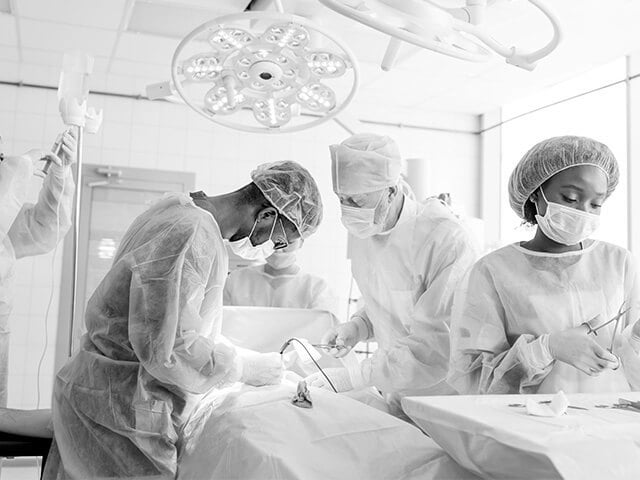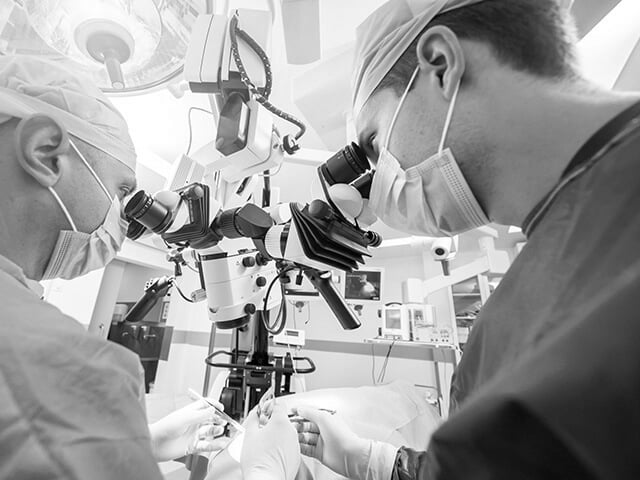Our physicians are among the top breast and general surgeons in New Jersey, a distinction honed through our advanced training and education, extensive experience, and cutting-edge procedures and techniques.
Welcome to the Premier Surgical Network
Expert Care You Can Depend On
in New Jersey
.jpg?width=1920&height=882&name=PSN-home-banner%20(4).jpg)
Expert Surgical Care for a Healthier Tomorrow
At Premier Surgical Network, we are committed to providing compassionate and comprehensive surgical care in New Jersey. Our team of highly-skilled surgeons specialize in the full spectrum of breast health, from preventative screening and early cancer detection to diagnosis and treatment for benign and cancerous breast disease. Our patients benefit from advanced surgical offerings like hidden scar lumpectomies and nipple-sparing mastectomies that provide optimal results. More importantly, we offer complete support for your mind, body, and spirit before, during, and after your treatment journey.
In addition to our excellence in breast surgery and breast disease care, we specialize in a range of general surgery procedures, including open and laparoscopic hernia repair, gastrointestinal procedures, and the treatment of skin and soft tissue disorders. It is our honor to be your trusted partner through this challenging time, empowering you to emerge healthier, at peace, and renewed in wholeness and confidence.
In addition to our excellence in breast surgery and breast disease care, we specialize in a range of general surgery procedures, including open and laparoscopic hernia repair, gastrointestinal procedures, and the treatment of skin and soft tissue disorders. It is our honor to be your trusted partner through this challenging time, empowering you to emerge healthier, at peace, and renewed in wholeness and confidence.
Our Specialized Surgical Services Offered in New Jersey
Our team understands how overwhelming a cancer diagnosis can feel. That is why Premier Surgical Network provides comprehensive, convenient care so you can focus on healing, not coordinating care between multiple offices. Our center offers a full spectrum of cancer and benign breast disease treatment, genetic counseling, and advanced biopsy methods. In addition to breast health, we specialize in skin disorder procedures, hernia repair, and gastrointestinal care - all with one specialized team. We care for you completely so you can move forward into health with confidence and peace. Our patients have access to the most advanced breast and general surgical care performed by expert surgeons:
Hear What Patients Say About Us


I’ve been with Dr.Suarez for about 5+ years and so far she has been one of the best Doctors I have seen. I love the way Dr.Suarez treats me as a patient. At first I was a little worried because some doctors can be rude but Dr.Suarez instantly made me feel comfortable she’s so nice and caring. I would definitely recommend her to anyone who needs her service! I have been with Dr. Suarez for over 5 years and so far she has been one of the best doctors I have seen. I love the way Dr. Suarez treats me as a patient. At first I was a little worried because some doctors can be rude, but Dr. Suarez instantly put me at ease, she is very kind and attentive. I would definitely recommend her to anyone needing her services!
Guadalupe A.


This is my second time seeing Dr. Suarez and she treated me like I have been seeing her for years. She listens carefully and gives all the time needed to her patients, she made me feel like I am the only patient she is seeing that day while I know she is very busy. I will look forward to my next appointment with her because she is different than other doctors with the amount of care she gives to her patients. Also her lead nurse Natasha Echavarria was very kind and made sure that I have all the information needed and provided me with her phone extension just in case I needed anything so I have direct contact with the the doctor’s office.
Mays S.


Dr Brown has been my breast Dr for over 10 years. From the first visit, she made me feel like family. She really is attentive to your needs and makes sure that she listens to all your concerns. I've had about 6 biopsies with her and each time, she made me feel so confident and comfortable. I can't imagine being with another Dr. I'm happyy to say that I now have my Mother & daughter going to her as well. She's the only one that I trust to take care of me and my family....I love Dr. Brown.
Anonymous


When I was told I had breast cancer for the third time and visited Dr. Adriana Suarez-Ligon I was terrified. I was to be evaluated for possible breast surgery. She was professional but also kind and compassionate, as she explained the options to me. Dr. Suarez-Ligon spent over an hour with me and supplied me with several means of communicating with her for any further questions. She offered me hope. Her office staff, especially her nurse, Daria, helped arrange all the prerequisites to surgery. Two weeks later, I had a successful bilateral mastectomy. I am healing well thanks to her skill as a surgeon. I strongly recommend her for any woman who needs an excellent breast surgeon. She will take the time you need to make decisions and offer support pre and post procedures.
Kim S.


Dr. Brown makes you feel loved and relaxed. She is caring, professional, and an amazing person! I would recommend anyone to come here
Anonymous


Team is amazing and so sweet Dr Suarez is an amazing beautiful surgeon her nurse Natasha is so pleasant and explained everything well
Giselavaz V.


Dr Chagares bedside manner and knowledge in his field is absolutely astonishing! He is a breath of fresh air while going through the whole process of surgery. He takes his time while in the room and doesn’t make you feel rushed or any question asked he answers without hesitation! His office staff is pleasant and always have smiles on their faces! Would recommend this doctor to anyone wanting to feel safe and secure!
Jennifer W.


[Dr. Brown]'s the best, very friendly.
Anonymous


I would Absolutely recommend Dr Chagares and his team. He is completely engaged and informative. He Smiles more than any Doctor I’ve ever seen and makes you feel like you are the only one that matters at that moment. His staff is extremely knowledgeable, thorough and helpful. This has been a wonderful experience and I Would recommend anyone to this practice. Thank You
Dawnell H.


Dr.Brown is a great surgeon who keeps me very upbeat and smiling at every visit. She answers any questions or concerns I may have and I’m very satisfied with the service I received. I would definitely recommend her to anyone. Her staff is also amazing. I love it here.
Anonymous


Dr. Frost is the best doctor and I have recommended him to everyone. My entire experience has been pleasant. He takes his time and really cares.
Pauline B.


Simply the best! If you’re looking for a compassionate, professional, intelligent, experienced surgeon….i can honestly say…Dr Iucci is outstanding!!! I trust her 100%.
Maria C.


Dr. Iucci is an amazing surgeon, and an incredibly caring, friendly person. At a time when I was very concerned about my surgery, she took the time to reassure and explain everything to me. She also has a great sense of humor! I'd really give her a 5+++ score!!
Pat S.


Dr. Chuang is the best physician I've ever had the pleasure of being a patient of. What truly sets Dr. Chuang apart is her care, even outside of regular office hours. I am very thankful for her taking the time out from her family to help ease me anxiety, even though she didn’t need to. She did it from the good of her heart. Her willingness to go the extra mile demonstrates her genuine commitment to her patients' well-being.Thanks to Dr. Chuang’s exceptional care, my outcomes have been nothing short of amazing. I wholeheartedly recommend her to anyone.
Rashmika


I recently had a cholecystectomy performed by Dr. Lisa Iucci, and I am so grateful for the exceptional care that I received. From my initial consultation, she took the time to explain the procedure in detail. The surgery itself went amazingly well. I attribute my quick recovery to Dr. Iucci's skill, expertise, and compassion! I highly recommend Dr. Iucci, if you are in need of surgery, specifically gallbladder removal!!
Maria C.


Like• CommentI Cant't thank Dr. Chuang enough fo the special, excellent care she has provided me during my recent surgery. She is a unique gift to all of her patients and she is great about explaining medical procedures in a way that was easy to understand. Her positive attitude made me feel more like a family member than a patient. Thank you for making room for me in your busy schedule. Dr. Chuang is an amazing physician and surgeon and an even more kind, patient,loving and special persond I can't say enough about her. I HIGHLY RECOMMEND HER!A grateful PatientJulie Kashian
Julie K.


Dr Brown is one of the kindest and most caring doctor I have met. She treats you like a friend instead of just a patient. Highly recommended. She truly is a wonderful person.
Lissa N.


Dr. Chuang is professional, she cares about her patients and immediately gives you the results so you don't spend any extra time worrying. The office runs efficiently as well. I would highly recommend her!
Anonymous


It was the first time visiting Dr. Chagares in his Tinton Falls office as a patient. He was the warmest and friendliest surgeon I have ever encountered in my 20+ years in the healthcare industry. He took the time to address my concerns and answered all of my questions without feeling rushed.
Keith G.


I love her integrity, professionalism, bed side manner, dedication, positivity and overall excellence. I would recommend her without hesitation to my family and friends. I have never had a better experience with another doctor in my life.
Anonymous


Dr. Chuang is very conscientious concerned and explains everything clearly. She is patient and makes you feel comfortable. I would absolutely reccommend her to others.
Anonymous


Dr. Frost and his staff were very kind and helpful. Examination was thorough and the procedure I had done wasn’t as frightening as I thought it would be. Results were given promptly. Dr. Frost explained everything clearly and thoroughly. Scheduling was easy.
DW


Office staff is organized and welcoming! Dr. D’Angelo is easy to talk to, explains everything well, and did a fantastic job! I cannot recommend her enough!
Bonnie R.


Answers all of my questions. Very personable. GreT bedside manner.
Carol K.


I was very upset when I first came in and Dr. D'Angelo explained everything to me and calmed all of my worries. I feel very comfortable with her!
Albida M.


Great thorough doctor
Anonymous


Very nice and thorough. Spent time with me and answered all my questions and concerns.
Anonymous


Service is always quick and she makes me feel comfortable’ would recommend her to anyone.
Jennipher


Dr. Iucci is a great Doctor, I would absolutely recommend her. I am very glad that I was able to have her help me through this process. She is very skilled, qualified, and I trust her decisions.
Anonymous


Dr.Iucci was so kind and gentle. She explained everything and was very thorough.
Anonymous


Dr. Iucci is a wonderful, caring physician who will take the time to listen to you and answer your questions. She doesn't rush you and she really cares about her patients. I am very thankful to have found her for my medical situation.
Patty


Emergency Appendectomy. Explained procedure in easy to understand language. Came to see me the day after surgery. The staff said that’s very unusual the surgeon didn’t come it must have been the attending physician. Not so it was Dr. Iucci. Very compassionate. At post operative check up again very personable. Showed me on the anatomy diagram on the wall how the procedure was done. I wish there were more surgeons like Dr. Iucci. Most see my husband in waiting room and I never see them again.
Maggie B.


My mother was recently re-diagnosed with breast cancer after 18 years in remission. We were all extremely worried and anxious but from the moment we met with Dr. Suarez and her team, they helped allay our fears and were extremely compassionate during this tough time. Dr. Suarez explained the diagnosis, procedure and next steps in thorough detail and in a way that made it easy for all of us to understand. Her nurse, Natasha, was so kind and responsive to our additional questions. We truly appreciate the entire team’s effort and guidance!
Anonymous


Dr. Suarez explains everything extremely well. She make me feel comfortable in her care. You can feel the warm in her personality and her care. I started with her in Trinitas and will follow her wherever she goes. I highly reccomend her. Her staff is excellent as well.
Anonymous


When I was told I had breast cancer for the third time and visited Dr. Adriana Suarez-Ligon I was terrified. I was to be evaluated for possible breast surgery. She was professional but also kind and compassionate, as she explained the options to me. Dr. Suarez-Ligon spent over an hour with me and supplied me with several means of communicating with her for any further questions. She offered me hope. Her office staff, especially her nurse, Daria, helped arrange all the prerequisites to surgery. Two weeks later, I had a successful bilateral mastectomy. I am healing well thanks to her skill as a surgeon. I strongly recommend her for any woman who needs an excellent breast surgeon. She will take the time you need to make decisions and offer support pre and post procedures.
K Shafer


The office is very clean. The nurses and staff are friendly. Not long wait time on arrival. Dr Suarez is an amazing oncologist. She Cares about her patients. Goes above and beyond. Dr: Suarez has provided me with great healthcare for over a year although it has not been an easy journey. I’m Blessed to be her patient.
Dorilys F


Yes I would recommend her to anyone she is friendly accurate takes her time to explain everything and makes you feel really comfortable
Anonymous


She is kind and makes you feel relaxed and very comfortable. She explains very well what you have and also the procedures you will be getting. Thank you! I have been going to her for 4 years and am still cancer-free.
Anonymous


Guided me through everything with ease and patience. Always available and the staff is awesome. I felt I was exactly where I should be!!
Lucy L.


The Dr. as well as the PA were so friendly & took their time. I immediately felt @ ease. Never once did I feel like I was being rushed out the door. What a great experience!
Anonymous


She is very bright with an excellent bedside manner. Her NP and the rest of the staff are first rate.
Agnes C.


Dr Tammaro is very kind and caring. She is an extremely bright and intelligent surgeon. She is easy to talk with and always puts my mind at ease with my many questions. She takes the time. She truly cares. The entire staff is very welcoming and friendly. Always so helpful with everything. They go above and beyond to make things easier for the patient.
Joanne A.


Dr. Brown is the most down to earth, very caring and makes you feel as if you were friends for years! She has made an extremely stressful situation so much more bearable, I was completely freaked out about my next appointment until I met her for the first time! I HIGHLY RECOMMEND her and her team!!
Jessica M.


The first people that greeted me was the receptionist. Both were very pleasant. I then saw Dr. Brown’s assistant who was very thorough, professional and courteous. And last, but certainly not least I saw Dr. Brown, a beautiful soul and optimist that I admire, respect and place my life in her hands. She has both good hands and good bedside manners. Many people will say the best care is rendered in places like Sloan Kettering, but I continually receive it locally with my team of professionals. Warm regards, Sheila Denise Cook
Sheila C.


Dr. Brown is wonderful, as is the staff in the office. She is extremely friendly and makes you comfortable with what can be a rather daunting experience. She performed a surgery on me in January and even leading up to the procedure, I felt comfortable and at ease. I have a barely visible scar from the incision, which I was worried about. I would recommend her to anyone and everyone that I know that was in need of a breast surgeon.
Maggie R.


The practice along with Dr. Brown are excellent. Easy check in, little wait time, nurses are wonderful & skilled. Dr. Brown is knowledgeable, kind & will give you all the time you need to discuss what your needs are. Thank you so much for all you do!
Lynne T.


Dr Brown and her entire staff are phenomenal. They have held my hand through this 5 year journey reassuring me all the way. It is with joy that I can say I am cancer free, due to her early detection and treatment. I recommend her highly.
A. Mewborn


Everyone here is fantastic. Dr. Saad, Dr. Iucci, Kayla and their whole team are very good at what they do and they have great communication and patience! Highly recommend.
Rachael W.


Very compassionate and professional with a side of sunshine. Staff is well trained and always professional. Never wait to be seen always make you feel comfortable and are easy to get ahold of at all times. Dr. D'Angelo and Dr. Saad did an excellent job with explaining and detailing treatment. Great bedside manner and professional.
Wendy R.


I was super impressed with this practice. From the initial contact made over the phone, making an appointment, to the front desk, medical assistant, surgery scheduler and finally Dr. Desiree D'angelo-Donovan they were ALL top notch!! I could not be happier with my experience! Highly recommend!
Kelly M.


Dr.D'Angelo is just wonderful. She's trustworthy, kind and very attentive. Her staff is always friendly, nice and patience. I am a new patient and was very much welcomed. So grateful and thankful for their services.
Nadine H.


The care I received was truly outstanding. The staff at the front desk were very friendly and professional. I was very impressed with Dr D'Angelo. She is thorough and has a calming personalized approach. I would definitely recommend Dr D'Angelo and her entire team.
Brian L.


Dr Tammaro is very kind and caring. She is an extremely bright and intelligent surgeon. She is easy to talk with and always puts my mind at ease with my many questions. She takes the time. She truly cares. The entire staff is very welcoming and friendly. Always so helpful with everything. They go above and beyond to make things easier for the patient.
Joanne A.


Guided me through everything with ease and patience. Always available and the staff is awesome. I felt I was exactly where I should be!!
Lucy I.


Dr. Chagares not only a super skillful professional with years of experience but amazing human being. From the very first moment you meet him you get charged with positive energy that comes from him. His warmth, smile, confidence all real, not fake. My hernia surgery and healing went very well! Entire staff was friendly and caring and I felt I was in good hands. I highly recommend this team. Thank you, Doctor Chagares, you are one of a kind!
Anatoly N.


I had an excellent experience with Dr. Chagares and his staff. The office is professional, efficient, and very easy to work with. From scheduling to the actual appointment, the process was seamless. I really appreciated the personalized attention and genuine care they provided. Highly recommend!"
Paul Y.


Always had a pleasant visit with the group. Dr. Chagares performed 3 different procedures and each went as he described. He has a great personality and made me feel comfortable. Gisele in the office is amazing as well. Highly recommend his services…
Jack S.


I like everything about Dr. Frost. He is very kind, professional and he is very knowledgeable in his field. He explains everything clearly and makes you feel confident in his abilities.
A. T.


When I first met Dr Suarez I was scared and confused and wanted a Dr that was not just good at their field but that cared for the patients. I was Blessed to have met Dr: Suarez. She made me feel comfortable right away. Her office is always very clean. Wait time is minimal. Her nurse and her team/ staff are all very nice and friendly. She has been a Great Oncologist and an Amazing Person full of compassion. Any patient would be lucky to have her as their Dr. She is knowledgeable in her field and aims to help patients improve their health and overall quality of life. Any Hospital or Dr would be fortunate to have her represent them. I’m grateful to have her with me through my long journey. However their is a down side. Dr Suarez Answering service and her office answering calls is an on going unpleasant experience. Hopefully she can eventually resolve this and get Office Assistance that answers calls and not always sends to answering service. Which it’s frustrating because messages don’t get received anyway. Thank you Dr: Suarez
Dorilys F


I met Dr. Iucci when I was admitted to the hospital with gallbladder issues. Immediately upon meeting her, I felt comfortable. I’ve had a lot of terrifying medical experiences over the years and to say that I was scared to have gallbladder surgery is an understatement. Dr. Iucci is easy to talk to and treated me like a friend. Surgery was smooth recovery was easy. I would definitely recommend her
Brenna P.


Dr Lisa Lucci is an excellent surgeon. Most likely an expert at using laparoscopic techniques. I had minimal pain post-op. She explained all aspects of my procedure well. I was fortunate to have her for the surgeon on call for my appendectomy procedure.
William S.
List
Map
Find a Location
- Brick, 08723
- Cape May Court House, 08210
- Egg Harbor Township, 08234
- Lacey Township, 08731
- Freehold, 07728
- Hammonton, 08037
- Linwood, 08221
- Manahawkin, 08050
- Glen Ridge, 07028
- North Bergen, 07047
- Red Bank, 07701
- Union, 07083
- Westwood, 07675
Brick
74 Brick Boulevard Building 4, Suite 205, Brick, NJ 08723
-
855-980-6981
-
Breast Surgery, Breast Reconstruction, Screening
Cape May Court House
106 Court House South Dennis Road Building 200, Suite 200, Cape May Court House, NJ 08210
-
855-980-6981
-
Breast Surgery, Breast Reconstruction, Screening
Egg Harbor Township
4096 English Creek Avenue Egg Harbor Township, NJ 08234
-
855-980-6981
-
Breast Surgery, Breast Reconstruction, Screening
Forked River
730 Lacey Road Lacey Township, NJ 08731
-
855-980-6981
-
Breast Surgery, Breast Reconstruction, Screening
Freehold (Main St.)
901 West Main Street Suite 363, Freehold, NJ 07728
-
-
Breast Surgery, Breast Reconstruction, Screening
Hammonton
219 N. White Horse Pike Suite 104, Hammonton, NJ 08037
-
855-980-6981
-
Breast Surgery, Breast Reconstruction, Screening
Linwood
222 New Road Building 6, Suite 603, Linwood, NJ 08221
-
609-601-1000
-
Breast Surgery, Breast Reconstruction, Screening
Manahawkin
517 NJ-72 Suite K, Manahawkin, NJ 08050
-
855-980-6981
-
Breast Surgery, Breast Reconstruction, Screening
Montclair
Mountainside Medical Center (Inside Harries Pavilion) 1 Bay Avenue Suite 4, Glen Ridge, NJ 07028
-
855-980-6981
-
Breast Surgery, Breast Reconstruction, Screening
North Bergen
7650 River Road Suite 240, North Bergen, NJ 07047
-
855-980-6981
-
Breast Surgery, Breast Reconstruction, Screening
Red Bank
331 Newman Springs Road Building 2 - First Floor, Suite 200, Red Bank, NJ 07701
-
855-980-6981
-
Breast Surgery, Breast Reconstruction, Screening
Union
950 West Chestnut Street Suite 102 , Union, NJ 07083
-
855-980-6981
-
Breast Surgery, Breast Reconstruction, Screening
Westwood
260 Old Hook Road Suite 304, Westwood, NJ 07675
-
855-980-6981
-
Breast Surgery, Breast Reconstruction, Screening
No Locations Found. Please Try Some Different Filters.
Our New Jersey Locations
Our team understands how overwhelming a cancer diagnosis can feel. That is why Premier Surgical Network provides comprehensive, convenient care so you can focus on healling, not coordinating care between multiple offices.





-min.png?width=640&height=840&name=Dr%20Desiree%20D%E2%80%99Angelo%20(1)-min.png)









